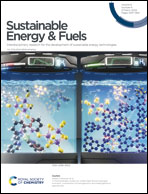Chemical sintering by chlorinated carbon compounds for flexible photoanodes of dye-sensitized photovoltaic cells †
Abstract
Novel binary solvent mixtures of chlorinated carbon compounds (CCs = CCl4, CHCl3, and C2Cl4) and 1-octanol are used to prepare pastes of TiO2 nanoparticles (NPs), which facilitate the formation of stable and thick TiO2 mesoporous films for photoanodes of dye-sensitized solar cells (DSSCs). CCs and 1-octanol readily form a complex, leading to enhanced interparticle connectivity within TiO2 NPs through hydrogen bonding interactions. The as-prepared chemically sintered TiO2 films exhibit high porosity and homogeneity, and a strong interparticle network for improved mechanical stability. The highest power conversion efficiency (PCE) of 7.0 and 5.8% is achieved using C2Cl4 for fluorine-doped tin oxide (FTO)-based rigid-type DSSCs and flexible-photoanode (indium-doped tin oxide (ITO)-coated polyethylene naphthalate (ITO/PEN))-based DSSCs, respectively, under 1-sun illumination conditions. Furthermore, the optimized device exhibits a significantly high PCE of 19.9% under indoor low-intensity light conditions.



 Please wait while we load your content...
Please wait while we load your content...